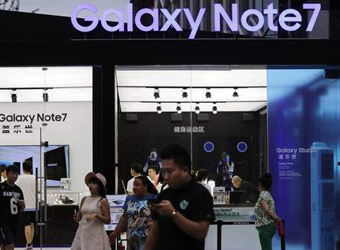Samsung Electronics has finally identified what went wrong with its Galaxy Note 7 handsets that led to one of the worst technology recalls in recent times, a day before announcing its full-year earnings.
Dong-jin Koh, Samsung’s mobile business chief, acknowledged two separate instances of battery malfunctions were to blame for some of the handsets catching fire at a Monday press conference in Seoul, South Korea. He also used the conference to apologize to customers and suppliers.
Investors responded positively to the news, with Samsung shares closing up 2.31 percent at 1,903,000 won during market close on Monday.
The Galaxy Note 7 handsets were packed with lithium-ion batteries, which are arranged in three layers: a positive electrode, a negative one and a third physical layer that acted as the separator between the first two. When the positive and negative electrodes touch, it can sometimes lead to short circuits within the battery cells.
Koh explained in the first set of batteries, which were rolled out with the original devices, there was an issue with the upper right hand corner of the battery cell. “Our analysis showed the main cause for the incidents was deflections in the negative electrodes,” he said, adding incorrect positioning of the negative electrode tip also led to a higher likelihood of incidents.
For the second set of batteries, which were supplied by a different manufacturer and were put into the replacement units, Samsung found melted copper on the negative electrode area. Koh said there were welding issues that led to contact between the positive and negative layers, resulting in short circuits.
“It does all add up,” according to Patrick Moorhead, president and principal analyst at Moor Insights & Strategy. But the odds of two separate battery manufacturers having issues in the same phone was incredibly low, he told CNBC’s “Squawk Box” on Monday.
Samsung hired 700 engineers to test out 200,000 Note 7 devices and 30,000 batteries, and engaged external investigators from independent safety science company UL, consulting firm Exponent and German technical services provider TUV Rheinland to probe the issue as well.
In a bid to regain customer confidence, Samsung said it implemented a range of quality control and safety measures for their handsets, including an 8-point battery safety check. The next major product launch for Samsung will be their flagship Galaxy S8, which is expected in March or April, according to various reports.
Moorhead reckons Samsung’s product safety initiatives would only convince customers if the company is able to go the next few years without having any major product safety issues, but he added the Note 7 incident served as an inflexion point for the industry to re-look at the way lithium-ion batteries were made.
The problems with the Galaxy Note 7 began just days after its launch in August, when reports emerged that handsets caught fire related to an overheated battery. In early September, Samsung issued a recall of 2.5 million handsets in 10 markets, according to Reuters. Shortly after the replacement devices began rolling out, fresh reports of those devices catching fire surfaced, which ultimately led the South Korean giant to permanently discontinue the line.
Samsung had said it expected to book an operating loss of over $5 billion, spread over the last two quarters of 2016 and the January-March 2017 quarter. But in earnings guidance for the October-December quarter, provided earlier this month, Samsung expects a 50 percent on-year jump in total operating profits, due to strong performances in the memory and display businesses, and some recovery in the mobile division.
Koh told the media on Monday that 96 percent of about 3 million Note 7 devices sold and activated have been returned globally.
Source: CNBC


